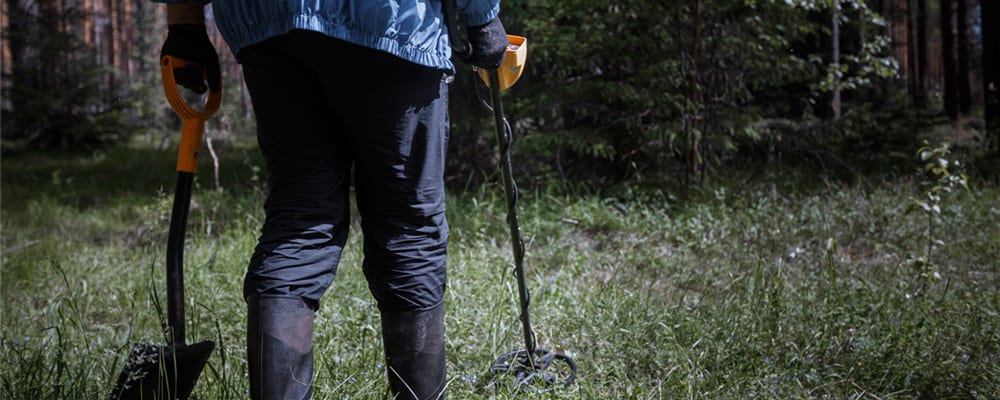Coins are some of the most desired types of targets for metal detectorists. Modern coins can be cleaned up and spent (free money!) and for those interested in history, it can be an amazing experience to hold a coin that someone lost decades or centuries ago. To help you in your own metal detecting adventures, this article will take a broad look at some metal detecting tips for coins.
What is coin shooting?
Coin shooting is in essence metal detecting specifically for coins. By extension, a coin shooter is a metal detectorist who is most interested in finding coins and tailors their style of hunting towards that goal. Coin shooters of course dig up all kinds of targets other than coins and those whose interests aren’t primarily coins will rarely pass up a good coin signal. So, one might ask, what’s the real difference? The difference comes down to this: narrowing down what sites you’re searching and what signals you dig when detecting can help you avoid the worst of the trash and maximize the types of finds you’re trying to score.
How deep can metal detectors detect coins?
The depth at which you can find coins greatly depends on your machine, the size of the coin, and the orientation of the target. Detectors from decades past might be hard-pressed to find a coin more than four inches deep, but many of the popular and common detectors on the market today, such as the Garrett AT Pro or AT Max and the Minelab Equinox, can find coins at depth of up to a foot and maybe a bit more in some cases. Getting that deep will typically require ideal soil conditions and an experienced user – don’t count on hitting coins at a foot deep on your first outing or in patches of heavy iron.
Size is also a factor. As a general rule, the larger the coin, the easier it will be to detect at depth. Your mid-level modern detector might be able to “see” an Eisenhower dollar at 14 inches in good conditions, but not a wheat penny or a dime. That said, your detector will also “see” coins less clearly at the depth and you might mistake that Eisenhower dollar signal for a crushed pop can at 10 inches. A coin’s perceived size will also be affected by its orientation in the ground. Fortunately for detectorists, coins most often lay in the ground more or less parallel to the surface, i.e. facing heads up or tails up. But sometimes coins are found “on edge”, or in other words, perpendicular to the surface. This changes what the detector sees beneath the ground and can reduce depth. Unfortunately, there’s not much that can be done to remedy this other than learning your machine as best you can and digging iffy signals.
Will a metal detector detect all coins?
The types of coins you can find with a metal detector are going to be limited, as with all other metal detecting finds, by what type of human activity occurred on your site in the past. If you put in your research and get permission to detect at an old stagecoach stop, you could find old silver coins and even gold, if you’re very lucky. Metal detectorists outside of North and South America could potentially find coins dating back to antiquity. But Roman coins and Spanish doubloons, while possible to find in the right place, are not the norm.
Modern coins
Realistically, most of the coins you find will be relatively shallow and from the recent past. If you’re from the United States, this will mean clad coinage. Most coins minted for circulation after 1964 (and all after 1970) have no silver content and are made by bonding a copper-nickel alloy to a copper core to give the coins a shiny, silvery appearance. Pennies were made from copper until 1982 but have since been minted in zinc. If you live outside the US, the metallic composition of your coinage will probably differ, but steel and cupro-nickel coins are common all over the world.
While these coins aren’t massively exciting, they do add up. Avid detectorists can rack up hundreds of dollars in change in a year and turn their pennies and dimes into new equipment, silver coins, or whatever suits their fancy.
Silver coins
Prior to the middle of the twentieth century, most places in the world had circulating silver coinage, but this had essentially been phased out by the 1970s. For metal detectorists, this means that anyone wanting to find silver coins should search sites where humans were active prior to the phasing out of silver coins. To give an example, the last year that widely circulating silver coins were minted in the US was 1964. If you search houses, parks, churches, etc. from before that era with patience and good technique, you will find silver. Some coin shooters make silver coins their primary target and might rack up hundreds in a single year. While impressive, having that type of success involves a lot of research, hunting time, and often time spent driving to fruitful locations.
Gold coins
Most of us who have spent time metal detecting have imagined finding a gold coin. Maybe you even know someone who has found one. But the unfortunate fact is that finding a gold coin is very difficult, much more so than finding a gold ring. People in the past must have been particularly careful not to lose a gold coin and gold hasn’t circulated as currency for close to a century in many parts of the world. That said, it can be done! It is easier to accomplish in the western US where gold circulated more freely or in countries with a very long history. And as with all metal detecting finds, you increase your chances of success with research and perseverance.
Where can I find lost coins?
The types of locations you should search when coin shooting depends quite a bit on the types of coins you’re looking for. If you’re looking for modern, spendable coins in large numbers, parks, sports fields, schools, and fairgrounds are good places to start. Some of the best places to find silver coins are the yards of houses built from 1900 to 1950. Silver coins circulated widely in the United States in this era and houses of this age are less likely to have been hit by other metal detectorists than very old homes. Older parks, schools, and churches can also be productive. Where do you find that elusive gold coin? Do your research, hit old homesites and public gathering places (the 1800s or earlier is best), and bring all the luck you can muster.
Type of metal detector to use on coins
Any metal detector will be able to find coins, but some are of course more suited to the task than others. Very few detectors on the market are designed with only one use in mind, say coin shooting or relic hunting. They are more often intended as multi-purpose machines that could successfully be used for hunting coins and relics at a wide variety of sites. And since coin shooting is very popular, most detectors are designed with some thought to finding coins. The exception to this might be machines for finding gold nuggets and flakes, which tend to be more specialized than your average detector.
Modern multi-frequency machines like the Minelab Equinox are some of the better detectors out there for coin hunting, but somewhat less expensive options like the Garrett AT Pro and the Nokta Makro Simplex are strong performers as well. If you want to know more about what features and detectors will help you find coins, read our guide to the best metal detectors for coins.
How do you set a metal detector for coins?
If you’re looking for coins and trying to exclude other targets, discrimination will be your most important setting. Many popular machines have preset modes for coins or will allow you to set up the detector to discriminate out metal up to a certain threshold. Copper, brass, and silver coins are highly conductive and will rarely be discriminated out, but some gold, cupro-nickel, steel, and zinc coins may be excluded if you rachet up your discrimination settings.
Ground balance is another important setting for coin shooting. Basically, ground balance will help your detector account for and filter out the “noise” of the soil and its minerals. At 3”, improper ground balance might not seriously affect your ability to find a target, but at 9”, it will certainly have an effect. Unfortunately, some detectors available at a lower price point do not have an adjustable ground balance, which can hurt your depth in less-than-ideal conditions – this may be something to consider for your next detector purchase.
Tools of the trade
Other than your detector, you’ll need a digging tool, such as the ever-popular Lesche. For seriously deep coins or targets ensconced in tree roots, you may also want to consider a full-size shovel. Root Slayer and Predator Tools are favored brands, but be prepared to pay more for a specialized shovel. For sites that require a more delicate touch (and where targets are shallow), some detectorists use a probe. A probe is simply a small metal rod used to get under a coin and pop it out of the ground with minimal damage to the grass. A probe can be as simple as a flathead screwdriver, but brass probes are preferable so as not to scratch potentially valuable coins. There is definitely a learning curve to using a probe, but it’s a great skill to have if you can master it.
In my view, a pinpointer is a must-have piece of equipment if you’ve decided metal detecting is the hobby for you. It cuts down recovery time considerably and makes finding small targets like pennies and dimes much easier. The Garrett ProPointer is a very popular choice but is a bit pricey for some. Most manufacturers have their own pinpointer model however and even a cheap pinpointer is better than nothing.
Final thoughts
Coin shooting is one of the most popular forms of metal detecting for good reason. It’s fun, it can be financially rewarding, and finding the right coin can appeal to the history buff in all of us. So get out there –maybe you can check that gold coin off your bucket list.

